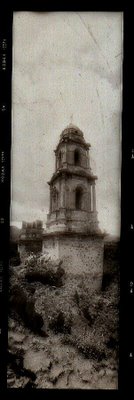Horseless Carriages & Digital Wonders
Thursday, September 28, 2006

Not too long ago I got into one of those senseless arguments about film versus digital. These arguments are no different from religious or political ones. None of the participants will give ground and the argument will end in shouts, flaming and insults. But this time I was into something. The guy on the digital end said my scans of my original transparencies (large slides) and negatives were poor imitations of the real thing.
I thought about "the real thing". I got back to him by saying that in reference to my slides and negatives, I could burn them, twist them, project them, print them, even ignore them in a shoe box and if I wanted to I could even chew on them. "Where is your original? Is it a series of 1s and 0s inside a memory card? Can you touch and chew those 1s and 0s?" The guy on the digital end had no way of refuting this and the argument ended in my "victory".
Photography is in a hard to predict transition. Those who shoot digital are out to prove how their digital cameras can mimic film and print large images and ask you to guess if they are digital or photographic prints. This is senseless. What would you think of a person driving a horseless carriage that could deposit stuff on the street every few blocks that looked just like horse droppings? What would we think if the horseless carriage were to spray your own vehicle with a steaming yellow liquid?
Digital photographers must look into the future for indication of where they are going and should leave us, who shoot film, in our past.
Of that past Roland Barthes wrote eloquently in his Camera Lucida - Reflections on Photography:
One day, quite some time ago, I happened on a photograph of Napoleon's younger brother, Jerome, taken in 1852. And I realized then, with an amazement I have not been able to lessen since: "I am looking into the eyes that looked at the Emperor." Sometimes I would mention this amazement, but since no one seemed to share it, nor even to understand it ( life consists of these little touches of solitude), I forgot about it.
That photographic past can sometimes crop up into our present. I took my Dresden made Noblex 175 to our Morelia, Michoacán, Mexico vacation in August. The camera, which has a swiveling wide angle lens, takes a picture that is 50mm by 175mm. The b+w negatives I took were too big for the 4x5 inch limitation of my scanner's negative/slide lightbox. I decided to place the negatives right on the scanner bed and placed a sheet of white paper on top. I scanned it and got a negative image. When I reversed the image (with Photoshop) the result was earie. It looked like a William Henry Fox Talbot, "Talbotype". These (taken in the 1840s) were paper prints made from paper negatives that were sandwiched on to sensitized paper to make a positive. Here you see the partially buried church of San Juan Parangaricutiro not too far from the Paricutin volcano that first erupted in 1943.






